Woodlawn's Debt to the Public
October 6, 2014
In two earlier articles, we sketched Woodlawn’s history as a tax exempt nonprofit, the promises it made to Dr. Brubaker, the tax breaks it received in the PA Clean and Green Program, and its unsavory history as a discriminatory landlord. In “The Real Woodlawn,” “Neither Clean Nor Green,” and “The Betrayal of Dr. Brubaker,” we pointed out that Woodlawn had purchased most of the land in Beaver Valley when it was a tax exempt charity. For this installment of the Woodlawn saga, we want to elaborate on our earlier revelations.
The IRS Comes Knocking
Through the 50s and 60s Woodlawn was able to gobble up most of the farms between 202 and the Brandywine River, from Smithbridge Road all the way to Wilmington because it had substantial, excess funds in the form of public money (non-existent tax bills). In the mid 60s, the IRS determined that Woodlawn was acting more like a developer than a charitable foundation and decided that it did not merit tax exempt status. The IRS therefore retroactively billed Woodlawn for unpaid taxes from 1951 to 1964. Woodlawn subsequently sued the IRS in the late 60s -- to recoup the $1.1 million it had paid -- and won. Despite having spent large sums on attorneys’ fees to argue that they deserved to be treated as a charity, Woodlawn made a surprising move. Shortly thereafter the trustees themselves decided to drop Woodlawn’s tax exempt status and instead become a tax paying corporation -- no different in form than say Walmart, Monsanto, Exxon, or BP but without the ability to pay dividends. We think they did this because of the tax reform act of 1969 which mandated that charitable foundations spend a greater portion of their funds on actual charitable work. Woodlawn couldn’t demonstrate that it could meet the requirements the new law set for charitable foundations, so we believe it relinquished its tax exempt structure because it felt it could fare better as a tax paying corporation with copious deductions and write offs. We don’t know whether it’s driven by nostalgia or a less noble motive, but nearly fifty years later, Woodlawn is still portraying itself as a charity even as it plans to develop close to 800 acres of land acquired in large part with public money.
When the IRS sued Woodlawn, this is what the examining agent wrote about its land development activities:
"The holding, subdividing, developing and selling of land clearly stands alone as a separate, independent activity in Woodlawn’s program. It has no relation to the rental housing program. It has no relation to the establishment of public parks; indeed, the more land that is sold to private purchasers the less is available for public uses. Only a few small tracts have been dedicated as park land, and these have served to increase the salability of the lots.
In view of the above, it is the conclusion that gains from the sale of the subdivision lots constitute unrelated business taxable income, and are subject to the tax imposed by section 511 of the Code."
~Eugene F. Cassidy, Internal Revenue Agent
Woodlawn’s Creative Use of Accounting...and the English Language
The trustees’ most recent decision to sell off 325 of their remaining 800 acres to one of their fellow board members (Richard Julian) -- and to a nationally opposed big box retailer which encourages its employees to use welfare programs -- could not more clearly illustrate how Woodlawn says one thing and does another. In an attempt to influence public opinion in advance of these dealings, early press releases and public statements made by Woodlawn representatives characterized the sale of 1,100 acres to Mount Cuba as a “donation.” To avoid paying taxes on 21 million dollars from this transaction, they transferred the ownership of the 1,100 acres to one of their non profit affiliates called Rockford Woodlawn which Vernon Green, Benjamin Lovell (the shoe store owner), and Rodney Lambert control. Vernon Green and Rodney Lambert are the vice president and president of Woodlawn. Rockford Woodlawn then sold the land to Mt. Cuba. Strangely, Woodlawn’s website still touts its “land preservation efforts” even though it’s one of the largest developers in New Castle County, having only built several large unaffordable housing developments like Alapocas, Tavistock, Edenridge, Woodbrook, and Sharpley. In contrast, actual land preservation organizations typically buy up land and put in place conservation easements or other restrictive covenants in order to set up permanent protection, or they donate their acquisitions to agencies like the National Park Service, as was the case with Mount Cuba and The Conservation Fund.
Vernon Green of Woodlawn addresses the May 14, 2013 meeting at Garnet Valley Middle School, stating that Woodlawn "transferred over..." the land that became the First State National Monument. Actually, Woodlawn sold the land for $21 million.
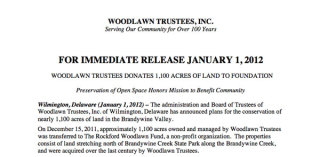
Early press releases from Woodlawn characterized the 21 million dollar sale of its land as a "donation."
The Parcels in Beaver Valley
The 325 acres now currently threatened by development are made up of seven former properties that Woodlawn purchased from 1954 to 1981, six of the seven acquired prior to 1967 when Woodlawn was a tax-exempt charity. The last purchase in 1981 was the Brubaker estate. This last 51 acre acquisition comes to about 15% of the total threatened land in BV, but also represents “The Big Promise” that we wrote about in “The Betrayal of Dr. Brubaker.” (We’ll come back to that) In other words, 85% of the wildlife refuge Woodlawn intends to pave over was bought in large part with taxpayer money.
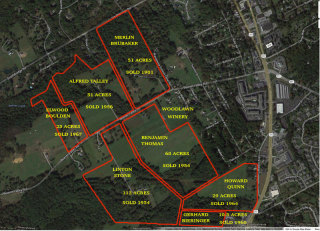
This Google Earth view of the valley shows the seven properties Woodlawn acquired in the Concord Township portion of Beaver Valley.
How Much of Beaver Valley Do We Own?
These six farms in Beaver Valley were purchased when the average federal corporate tax rate from (1954 until 1967) was 50%. As a charity, then, Woodlawn had just about twice the purchasing power of other development corporations when it bought its properties in Concord Township. Instead of being able to buy just half of Beaver Valley, its tax exempt status gave it the ability to purchase ALL of it, and until it voluntarily gave up its tax-exempt status, paid virtually no taxes -- as far as we can tell -- on the land it held. Since tax money belongs to the public to be used for the public good, the public has a legitimate claim to much of the Beaver Valley land (approx. 43%) that Woodlawn would now develop for the personal profit of one of its board members (Richard Julian). If we add in the Brubaker promise on Beaver Valley Road the total comes to 58%.
Beaver Valley needs you at the Oct. 20th meeting!
Monday, Oct. 20th, 6pm at the Garnet Valley Middle School.
Pennsylvania Hands Woodlawn a Pot of Gold
After the reorganization in the late 60s, Woodlawn looked for other ways to lower its tax bill now that it was no longer federally tax exempt. Happily for them, the PA Clean and Green Act (Act 319) was passed in PA in 1974, allowing them to reap substantial tax savings in exchange for designating their land in Pennsylvania as a “wildlife refuge” and for making the land available for public use. Bear in mind that the purpose of Act 319 was to encourage landowners to keep their land open -- permanently. It certainly wasn’t created to allow developers to enjoy tax breaks until they decided to profit from the development of the land. Sadly, despite preening itself as an open space protector, establishing a tax shelter seems to have been Woodlawn’s only motive for creating the wildlife refuge. Prior to that, it paid security guards to keep the public out of Beaver Valley. Now that it plans to violate the spirit of Act 319, which doesn’t fully penalize owners who develop their land, Woodlawn is only required by law to pay back only a small fraction of the taxes it saved from being in the program. By developing Beaver Valley instead of selling to a conservation group, Woodlawn would actually be shafting the taxpayer for the second time. Let’s not forget either that Woodlawn has received in excess of a hundred million dollars over the last seven decades from renting out its 473 affordable housing units in Wilmington, leasing their fields to local farmers, renting out dozens of its “country houses,” and interest on its investments.
Brubaker Redux
Dr. Brubaker’s 51 acres were purchased in 1981 after Woodlawn gave up its tax exempt status, but as we pointed out in our first Brubaker article, he only sold to Woodlawn on the condition that they protect his land from development. The evidence for this fact is almost as overwhelming as how much Woodlawn has saved in taxes on the Brubaker property via the Clean and Green Program. Then there’s Brubaker’s barn, dating to about 1772, which remains in excellent condition after he restored it in the 1940s. The foundation for this barn was laid four years before Thomas Jefferson laid the foundation for the United States in his Declaration of Independence. Strangely, for all Woodlawn’s professed regard for history on their website and in their press releases, they don’t seem to have any regard for this very tangible and valuable piece of history.(1) Horse owners still use that barn and are able to access all of the trails in Beaver Valley from that central location. Frank McKee’s and Richard Julian’s bulldozers will roll over this barn just as soon as they’re able.
1. There are actually dozens of historically valuable ruins and artifacts all over Beaver Valley. Brubaker’s barn is in pristine condition.
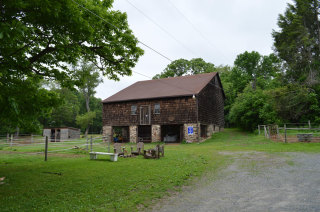
Lorem ipsum dolor sit amet, dolores maiestatis sed te, sint similique te vim. Dicam luptatum sapientem qui cu, ei prompta utroque efficiendi eam. Cu mei omnis oporteat pertinax, ei duis veniam propriae mea. Et alia recteque efficiendi mea. Pri at velit falli intellegebat, ut vix munere electram.
Another Broken Promise
When we wrote the Brubaker article, we didn’t have the details on another promise Woodlawn made to a different landowner in Beaver Valley. It turns out that Woodlawn also made a promise to protect the 25 acre farm it acquired from Reba and Elwood Boulden in 1967. This property sits on the north side of Beaver Valley Road adjoining the First State National Monument. Children, grandchildren, nephews, nieces, and others have all stated with absolute certainty, that, like the Brubakers, the Bouldens wanted their land in Beaver Valley preserved. And so did Woodlawn if we’re to believe their own internal memos. Reba and Elwood appreciated the importance of Beaver Valley and so wanted their farm left alone for future generations to enjoy. Sadly, the promise to preserve that land has long been forgotten as the historic Boulden Farm awaits demolition. John Jaros, Woodlawn, Frank McKee, and Richard Julian simply ignore this history and speak instead of “by right plans” and “property rights.” But what about the property rights of Clara and Merlin Brubaker and Reba and Elwood Boulden? What about the rights of taxpayers who helped pay for the purchase of Beaver Valley? What about the de facto public trust Woodlawn created with the designation of its lands as a “wildlife refuge”?
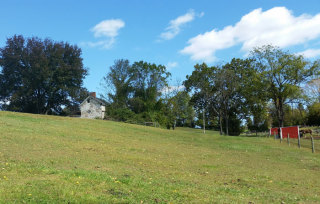
The Boulden farm house was built in 1809 and is one of the several important historic structures slated to be demolished by Frank McKee and Richard Julian.
This internal memo shows Woodlawn wanting to save Beaver Valley in 1995:
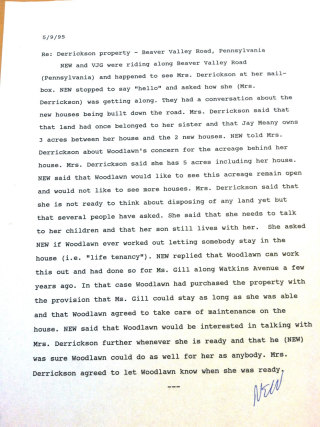
Who is Misinformed?
Back in May of 2013, Vernon Green was quoted along with Dominic Pileggi (Concord Supervisor) in the News Journal as saying, “[those who oppose the development plans] mean well, but are misinformed.” Clearly, at the time we were misinformed. We had no idea just how much Woodlawn had been subsidized and how far it has gone to portray itself as a “charitable” organization despite being a development corporation. We won’t deny that Woodlawn has done some good in the creation of parks in Wilmington, but it’s been many decades since it donated land for the public good. Here’s Woodlawn’s chance to match its rhetoric with its founder’s intent and in the process make a very nice sum for its affordable housing in Wilmington. We are not asking them to give the land away for free. To that end, Woodlawn should meet with area residents and/or conservancies to discuss a price for saving Beaver Valley and to allow time to raise the money. They will be well compensated. William Bancroft wanted to protect parkland for future generations, and so do we. Selling the threatened land to folks who actually want to preserve it for future generations would be a huge win for them, for Brandywine Valley residents, Garnet Valley School District taxpayers, and for posterity. Everyone wins. Open space gets protected and Woodlawn makes millions.
Woodlawn, contact us at: william.poole.bancroft AT gmail com to set up a meeting.
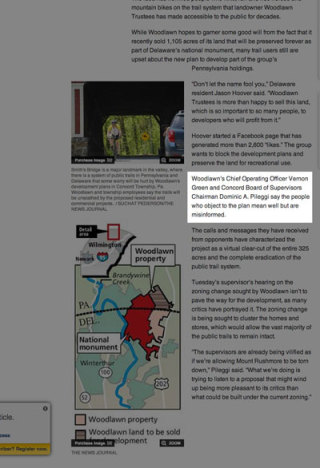
Vernon Green and Dominic Pileggi did not say how we were misinformed.
Article written by Ken Hemphill
If You Found This Article Useful...
Save The Valley is funded exclusively by donations from people like you. Articles like these are critical in keeping the public informed about important issues relating to Beaver Valley but require donations to keep them going. If you find this article valuable, please consider making a donation today. No amount is too small. Your donations are a critical part of keeping this effort going. Please donate today!